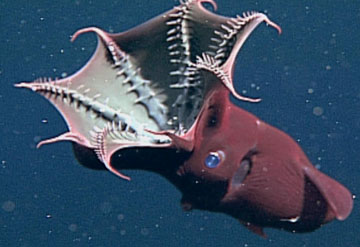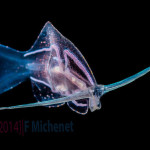Delving into the evolutionary past of the enigmatic deep-sea vampire squid, Vampyroteuthis infernalis, has long been a pursuit shrouded in mystery. However, recent discoveries, such as a remarkable specimen unearthed from the Early Jurassic of Luxembourg, are shedding new light on the early anatomy of vampyromorphs.
Enter Simoniteuthis michaelyi, a newfound taxon that has captured the attention of researchers worldwide. This remarkable creature, based on a nearly complete pen accompanied by a head-arm complex, is a brilliantly preserved fossil.

What makes Simoniteuthis truly intriguing is its unusual arm crown, boasting only four arm pairs instead of the expected five. This anomaly challenges our understanding of vampyromorph anatomy.
But the surprises don’t end there. Examination of the specimen’s mouth region reveals evidence of predation on two bony fishes. The two animals died in the act of predation, i.e. one had caught the other and had begun to nibble on it, when they possibly sank into hypoxic waters and suffocated.
Unlike its modern descendant, Vampyroteuthis infernalis, Simoniteuthis inhabited shallower waters, reminiscent of Mesozoic vampyromorphs. This divergence in habitat and hunting behavior offers valuable insights into the evolutionary trajectory of these captivating creatures.
Through meticulous analysis of the fossil record, researchers speculate that vampyromorphs began a vertical migration into deeper waters, possibly driven by shifts in feeding behavior, as early as the Oligocene epoch.
Fuchs, Dirk, Robert Weis, and Ben Thuy. “Simoniteuthis, a new vampyromorph coleoid with prey in its arms from the Early Jurassic of Luxembourg.” Swiss Journal of Palaeontology 143.1 (2024): 1-10.






